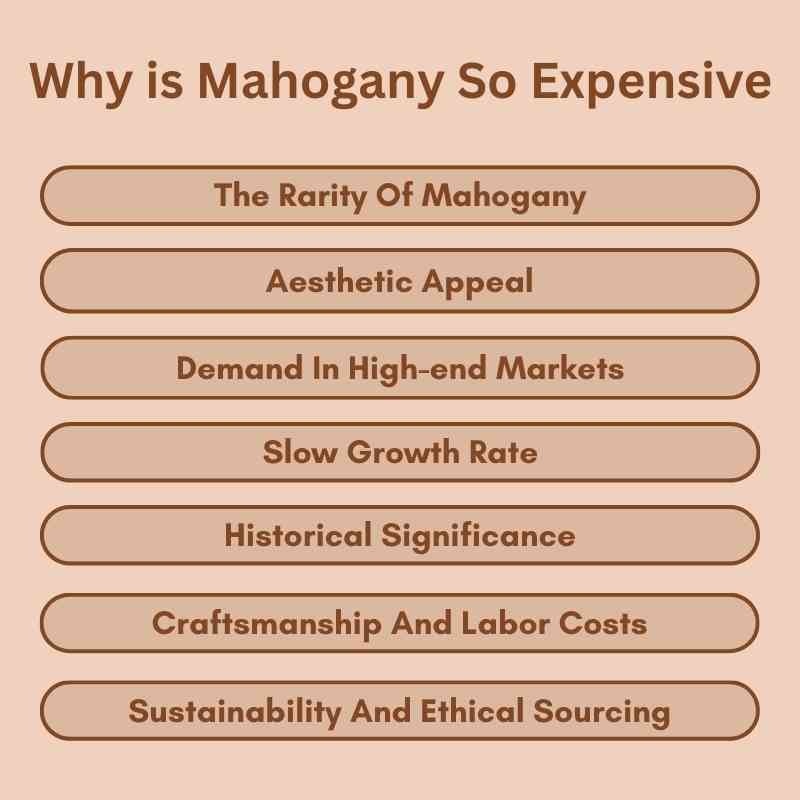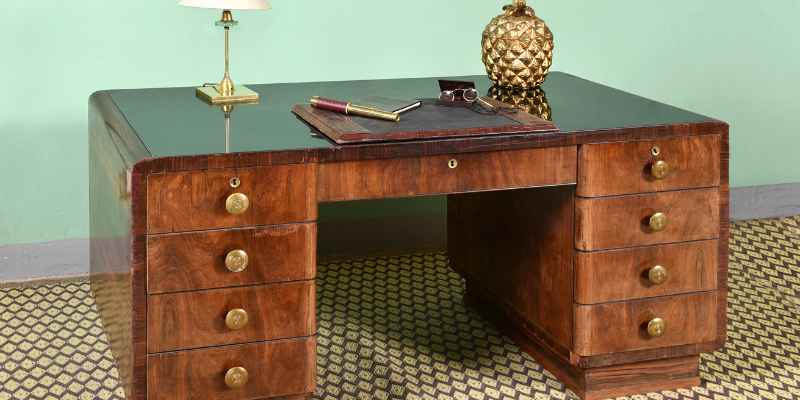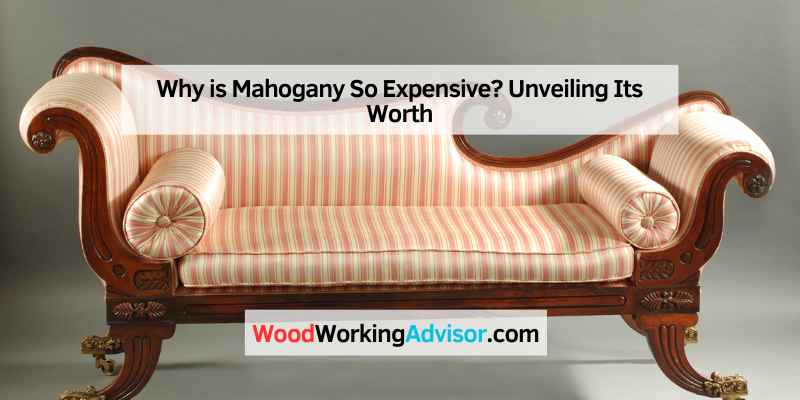Mahogany is expensive due to its rarity and high demand. Its slow growth rate and sustainable harvesting practices also drive up the price.
Mahogany has long been cherished for its beauty and durability, making it a premium choice in furniture and cabinetry. This tropical hardwood is known for its rich color and fine grain, appealing to both artisans and consumers. The tree takes decades to mature, limiting supply and contributing to its high cost.
Environmental concerns surrounding deforestation have led to stricter regulations on harvesting, further restricting availability. As a result, mahogany is not just a material but a luxury investment. Understanding the factors that influence its price helps buyers appreciate the value of this exquisite wood.
The Rarity Of Mahogany
Mahogany is one of the most sought-after woods in the world. Its beauty and durability make it a favorite for furniture and decor. However, the rarity of mahogany significantly impacts its price. Understanding this rarity helps explain why mahogany costs so much.
Limited Natural Habitat
Mahogany trees thrive in specific conditions. They primarily grow in tropical rainforests. Here are some key points about their habitat:
- They prefer warm, humid climates.
- Ideal soil is well-drained and nutrient-rich.
- Most mahogany trees are found in Central and South America.
Deforestation has reduced these natural habitats. Many mahogany trees face extinction due to habitat loss. This limited availability drives up prices. Collectors and builders seek out this rare wood.
Cites Regulations Impact
CITES stands for the Convention on International Trade in Endangered Species. This agreement regulates the trade of endangered plants and animals. Mahogany is on the CITES list due to overharvesting.
| Impact of CITES Regulations | Description |
|---|---|
| Trade Restrictions | Limits exporting mahogany without permits. |
| Higher Costs | Permits and regulations increase overall costs. |
| Illegal Logging | Drives up prices due to scarcity. |
The CITES regulations protect mahogany trees. They also make it more expensive. Buyers must understand these factors that contribute to mahogany’s high cost.

Exceptional Durability
Mahogany is prized for its exceptional durability. This wood can withstand various elements. Its strong structure makes it suitable for many uses. Durability plays a big role in its high cost.
Resistance To Decay
Mahogany offers excellent resistance to decay. It contains natural oils that protect it from moisture. This prevents rot and insect damage. Here are some key points:
- Natural resistance to mold and mildew.
- Repels pests like termites and beetles.
- Stands up well in humid environments.
This resistance makes mahogany ideal for outdoor furniture. It can last for years without needing much maintenance.
Longevity In Use
Mahogany is known for its longevity. Furniture made from mahogany can last a lifetime. Many people pass down mahogany pieces through generations. Here’s how it compares to other woods:
| Wood Type | Average Lifespan |
|---|---|
| Mahogany | 50+ years |
| Oak | 30-50 years |
| Pine | 10-20 years |
This longevity adds to its value. Mahogany pieces often become family heirlooms. They are worth the investment due to their durability.
Aesthetic Appeal
The aesthetic appeal of mahogany is undeniable. This wood captivates with its beauty. Many people choose mahogany for furniture and decor. Its stunning look enhances any space.
Distinctive Grain Patterns
Mahogany features unique grain patterns. These patterns create visual interest. No two pieces of mahogany are identical. This uniqueness adds value.
- Interlocking grain offers strength.
- Wavy patterns create depth.
- Smooth finish enhances the grain’s beauty.
Rich Color Depth
The color depth of mahogany is rich and warm. It ranges from light pink to deep reddish-brown. This variety suits many styles.
| Color Variation | Shade | Common Uses |
|---|---|---|
| Light Pink | Soft and airy | Cabinetry |
| Medium Brown | Classic and elegant | Furniture |
| Dark Red-Brown | Rich and luxurious | Musical instruments |
Mahogany’s rich color deepens over time. This aging process adds character. Many people love its evolving beauty.
Demand In High-end Markets
Mahogany wood has a strong presence in high-end markets. Its rich color and durability attract luxury buyers. This demand significantly influences its price.
Luxury Furniture Preferences
Many consumers desire luxury furniture made from mahogany. This wood is known for:
- Stunning appearance
- Long-lasting quality
- Resistance to warping
High-end furniture brands promote mahogany for its premium status. People choose mahogany for:
- Elegant dining tables
- Stylish chairs
- Classic cabinets
These furniture pieces often become family heirlooms. This adds to the wood’s appeal and value.
Premium Building Materials
Mahogany is a top choice for premium building materials. Builders and architects prefer it for:
- Custom homes
- Luxury yachts
- High-end cabinetry
Its durability makes it suitable for both indoor and outdoor use. Mahogany’s natural resistance to insects and decay enhances its appeal.
| Feature | Benefit |
|---|---|
| Durability | Lasts for decades without damage |
| Aesthetic Appeal | Beautiful grain and rich color |
| Workability | Easy to carve and shape |
These factors boost the demand for mahogany in luxury markets. As a result, prices continue to rise.
Slow Growth Rate
Mahogany is famous for its beauty and durability. One key factor driving its high price is its slow growth rate. This makes it a rare and valuable resource. Let’s explore how this growth rate impacts supply and harvesting restrictions.
Impact On Supply
Mahogany trees grow very slowly. They take decades to reach maturity. This slow growth has several effects:
- Limited availability of mature trees
- Higher demand than supply
- Increased prices for wood products
Due to its slow growth, mahogany cannot be harvested quickly. This leads to scarcity. The longer growth cycle means fewer trees are available for logging each year.
Harvesting Restrictions
Many countries have strict rules for mahogany harvesting. These restrictions help protect the environment. They also aim to ensure sustainable practices. Key restrictions include:
- Limitations on logging areas
- Licensing requirements for loggers
- Regulations on tree size and age
These rules lead to a slower supply of mahogany. Fewer trees can be harvested legally. This also drives up the cost of mahogany wood.
| Factor | Impact on Price |
|---|---|
| Slow Growth Rate | Lower supply, higher demand |
| Harvesting Restrictions | Increased costs and limited availability |
Historical Significance
Mahogany has a rich historical significance. It symbolizes luxury and craftsmanship. Its unique qualities have made it a favored material for centuries. Understanding its history reveals why it is so expensive.
Cultural Heritage
Mahogany is deeply rooted in various cultures. It has been used in many traditional crafts. Here are some notable aspects:
- Indigenous Practices: Many native cultures use mahogany for tools and art.
- Colonial Era: European colonizers favored mahogany for shipbuilding.
- Symbol of Status: Wealthy families used mahogany for fine furniture.
This wood carries stories and traditions. Its cultural significance adds to its value.
Antiques And Collectibles
Mahogany furniture is highly sought after in the antiques market. Its durability and beauty make it a favorite. Here’s why mahogany antiques are valuable:
| Factor | Value Impact |
|---|---|
| Age | Older pieces often have higher value. |
| Condition | Well-preserved items fetch higher prices. |
| Craftsmanship | Handcrafted pieces are more desirable. |
Many collectors look for mahogany antiques. The elegance and history of these pieces enhance their worth. Collecting them is a passion for many.
Craftsmanship And Labor Costs
Mahogany is famous for its beauty and durability. The high cost often comes from the skill and labor needed to work with this wood. Craftsmen invest time and effort to create stunning pieces. This craftsmanship adds to the overall expense.
Skill Required For Working
Working with mahogany requires special skills. Craftsmen must understand the wood’s properties. They need to know how to cut, shape, and finish it properly. Here are some key skills:
- Joinery: Creating strong connections between pieces.
- Finishing: Applying stains and varnishes for a polished look.
- Carving: Adding intricate designs to enhance beauty.
This skill level significantly raises the price. More skilled labor means higher costs for mahogany products.
Wages In Source Countries
The countries that produce mahogany often have high labor costs. Skilled workers expect fair wages for their expertise. Here’s a breakdown of typical wages:
| Country | Average Wage (per hour) |
|---|---|
| Brazil | $10 |
| Peru | $8 |
| Venezuela | $7 |
These wages reflect the cost of living in these countries. Higher wages contribute to the final price of mahogany products. Fair compensation ensures quality work and sustainable practices.
Sustainability And Ethical Sourcing
Mahogany is beautiful and durable. Its high price reflects its limited availability. Many mahogany trees are endangered due to overharvesting. Sustainable sourcing helps protect these trees and our forests.
Ethical sourcing means getting wood from responsible suppliers. This practice ensures forests remain healthy. It also supports local communities that rely on these resources.
Certified Sustainable Options
Several organizations certify sustainable wood sources. These certifications help buyers choose responsibly sourced mahogany. Here are a few key certifications:
- FSC (Forest Stewardship Council): Ensures wood is harvested sustainably.
- PEFC (Programme for the Endorsement of Forest Certification): Promotes sustainable forest management.
- Rainforest Alliance: Focuses on biodiversity and sustainability.
Impact On Pricing
Certified sustainable mahogany costs more than regular options. This higher price reflects responsible practices. Buyers pay for the assurance of sustainability.
Factors affecting the price include:
| Factor | Impact on Price |
|---|---|
| Certification Costs | Increases overall price |
| Limited Availability | Drives prices higher |
| Local Community Support | Enhances product value |
Investing in sustainable mahogany protects our environment. It also ensures high-quality products for future generations.

Frequently Asked Questions
Why Is Mahogany Considered A Luxury Wood?
Mahogany is considered a luxury wood due to its rarity, beauty, and durability. It grows slowly, making it harder to source. Additionally, its rich color and fine grain make it highly sought after for furniture and cabinetry. This combination of factors drives up its price significantly.
What Factors Affect Mahogany Pricing?
Several factors affect mahogany pricing, including availability, quality, and demand. Sustainable logging practices can also influence costs. The wood’s origin plays a role too; for instance, genuine mahogany from specific regions is more valuable. High demand for fine furniture and craftsmanship further escalates its price.
Is Mahogany Worth The Investment?
Mahogany is often worth the investment for several reasons. Its durability ensures longevity, making it a cost-effective choice over time. Additionally, mahogany furniture tends to retain its value well. The wood’s aesthetic appeal also enhances home decor, making it a desirable option for homeowners.
How Does Mahogany Compare To Other Woods?
Mahogany stands out for its rich color and grain, offering a unique aesthetic. Compared to softer woods, it is more durable and resistant to wear. While other woods may be cheaper, mahogany’s quality and beauty justify the higher price. It’s an excellent choice for high-end applications.
Conclusion
Mahogany’s high price reflects its rarity and quality. Sustainable sourcing and environmental regulations further drive costs up. Buyers appreciate its rich color and durability for furniture and cabinetry. Understanding these factors helps explain why mahogany remains a sought-after material. Investing in mahogany means choosing beauty and longevity for your projects.

